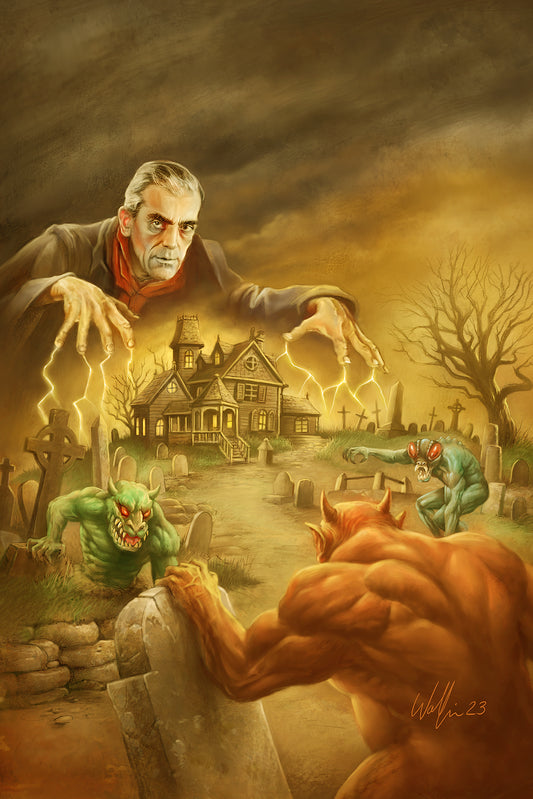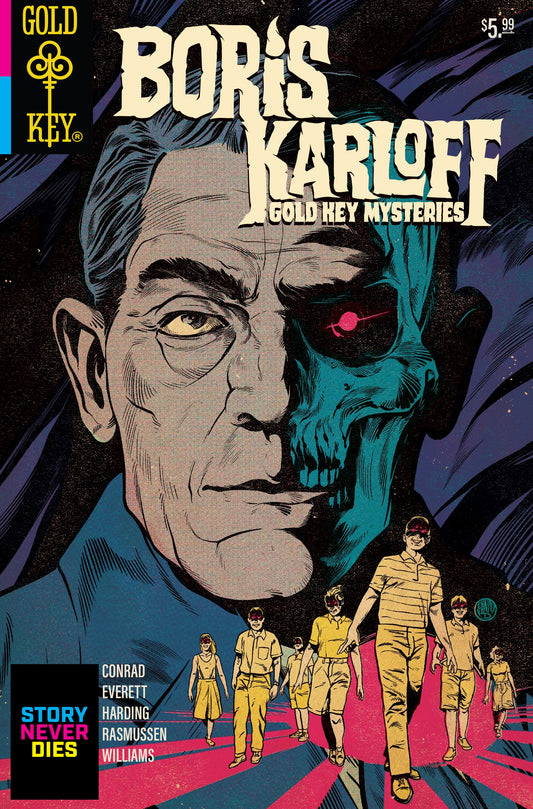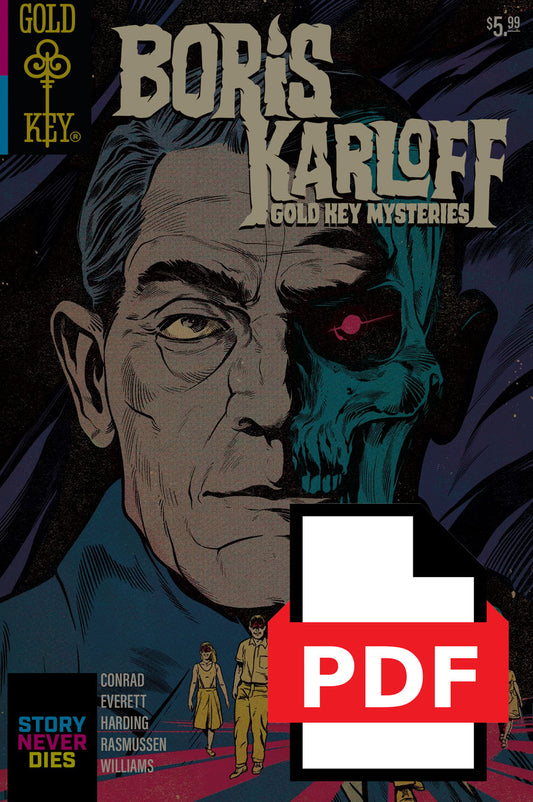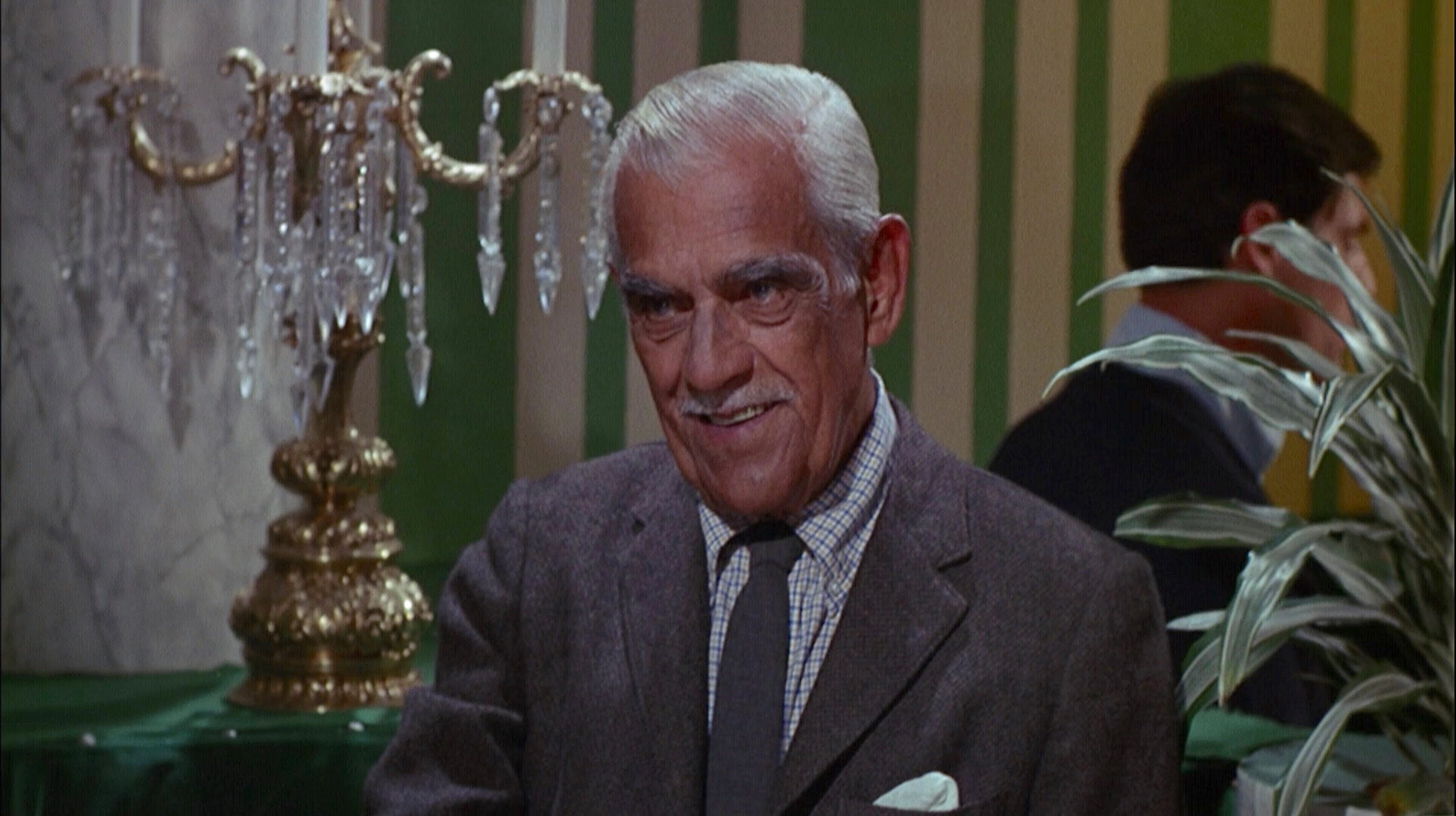
BORIS KARLOFF
All About "Karloff the Uncanny"

A Tribute.
In our first publication, Boris Karloff's Gold Key Mysteries (Gold Edition, offered exclusively on Kickstarter), we included an article on the great Boris Karloff. Below you will find this article in its entirety, we hope you enjoy it.
Boris Karloff, born William Henry Pratt, came into this world on November 23, 1887, in London, England to British and Indian parents. He would go on to become one of the most iconic figures in horror films, comics, and literature. His career spanned over six decades, during which he left an indelible mark on the entertainment industry and inspired generations. From Karloff’s unforgettable portrayal of iconic monsters in Frankenstein and The Mummy, as well as his role in founding the Screen Actors Guild, and his collaborations with legendary figures Val Lewton, Bela Lugosi, and Lon Cheney Jr., to his roles narrating children’s stories, his journey was purely magical.
Karloff’s path to fame was not a conventional one. After a brief military service in World War I, he ventured into acting, adopting the stage name Boris Karloff in 1919. His initial forays into acting were met with moderate success. He was 43 years old, and had already acted in 80 films, when he was given the role of the monster In James Whale’s 1931 film Frankenstein, permanently changing the trajectory of his career.
Frankenstein (1931)
Karloff’s mesmerizing performance as the misunderstood creature garnered critical acclaim and solidified his place in horror cinema history. With his expressive eyes and sympathetic portrayal, Karloff brought a profound sense of humanity and tragedy to the monster. His embodiment of the creature’s pain, isolation, and yearning for acceptance left an enduring impression on popular culture.
Boris Karloff would not have secured the role of Frankenstein’s monster without a little Hollywood magic. Initially, the studio offered the part to Bela Lugosi as a follow up to his recent success in Dracula. Lugosi refused, as he considered a non-speaking role to be beneath him. James Whale knew that casting the monster would be critical to the film’s success. Karloff’s relative lack of success made him perfect for the role.

When Whale spotted Karloff in the Universal Studios commissary one day, he knew he had his monster. He handed Karloff a note inviting him to screen test for the role. Karloff later quipped that he was offended that the part was for a horrible monster as he was wearing his best suit and thought he was presenting his most handsome visage.
Karloff’s legendary performance was a gift to the world, but it came at a price. The art of acting was different in those days: Actors took real risks that took a heavy toll. The role of Frankenstein’s monster required extensive makeup and prosthetics to transform Boris Karloff into the grotesque and tragic creature. The application process was arduous and time-consuming, taking hours to complete. Karloff underwent this grueling regimen of makeup application and removal at the hands of the brilliant makeup artist, Jack Pierce, on a daily basis. The iconic look of the monster, particularly the neck bolts, involved the use of a painful metal apparatus that had to be carefully fitted on Karloff’s head. This process caused his work days to stretch upwards of 20 hours.
The role of Frankenstein’s monster also imposed demands on Karloff as he endeavored to deliver a physically expressive and emotionally charged performance. “There were many days, when I thought I would never be able to hold out”, he said. The relentless pursuit of the monster by an angry mob, along with the constant portrayal of his anguish and loneliness, took a toll on Karloff both physically and emotionally: To convey the creature’s lumbering and stiff movements convincingly, Karloff had to maintain a specific posture and gait, which put a strain on his body during the filming process, and the need to emote without the use of the full range of facial expressions added another layer of complexity to his already demanding performance. Beyond these strains, during the production, Karloff suffered a dislocated hip, bruised ribs, and back injuries that would require multiple surgeries and cause pain that would plague him until the end of his life. In spite of these difficult conditions, Boris Karloff’s talent and dedication shone through in his portrayal. He injected a remarkable sense of humanity and pathos into the character, making it one of the most archetypal performances in cinema history. Despite the challenges he faced, Karloff’s enduring legacy as the tragic monster continues to captivate and resonate with audiences to this day.
Karloff was so unknown at the time of Frankenstein’s release that he was not listed in the movie’s credits or invited to the premiere. However, his performance as Frankenstein’s monster led to a string of unrivaled roles in classic fright films. The first of which was as the ancient mummy.
The Mummy (1932)
Karloff encountered similar challenges while playing the Mummy. The makeup team had to create a visually striking look which involved multiple layers of makeup, prosthetics, and bandages to create the eerie appearance of Imhotep. The application was time-consuming, and Karloff had to remain patient and still during the process.
Karloff’s portrayal of Imhotep in The Mummy once again left a lasting impact on the horror genre and cemented his place as one of the most talented actors in film history due to his uncanny ability to convey both fear and empathy in the villainous role .
The character of Imhotep is not simply a mindless monster but a tragic figure with complex emotions and motives. Karloff had to rely on skills he had developed while playing Frankenstein’s monster to use subtle facial expressions and body language to communicate Imhotep’s longing, anger, and vulnerability. This required a level of expertise that, even today, few actors can surpass.
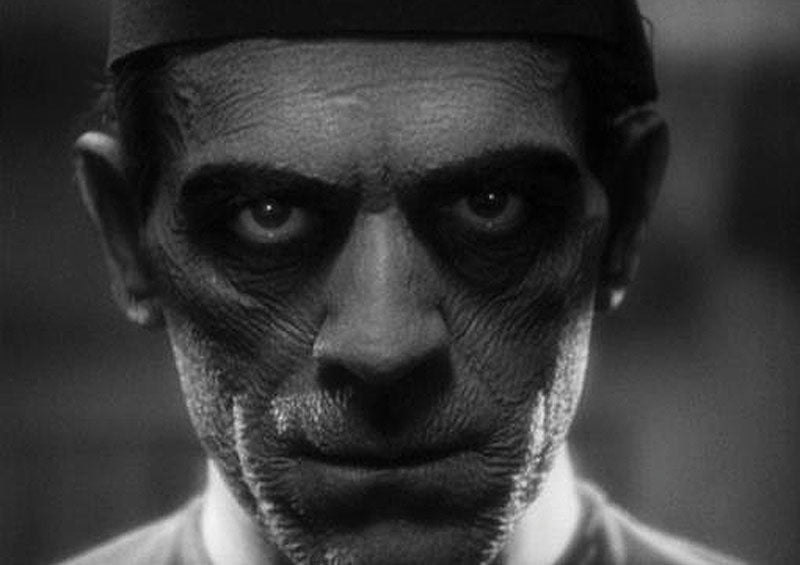
Screen Actors Guild (SAG)
His distinctive voice and commanding presence made him the first choice for monster and villain roles alike. However, Hollywood, in the early 1930s, was rife with exploitation and abuse of actors, who had little to no say in their contracts, working conditions, and wages. Karloff, older than most actors, took a stand to bring about change for those who followed him. Despite his success, he had experienced the darker side of the entertainment industry and was deeply troubled by the mistreatment of fellow actors. Karloff’s motivation to fight against these abuses stemmed from a heart of empathy and compassion for them. He recognized that the industry’s mistreatment not only affected individual performers, but also had broader implications for the entire acting community. Determined to bring about positive change, Karloff sought ways to protect actors’ rights and welfare.
Boris Karloff, along with other concerned actors such as Ralph Morgan, Ralph Bellamy, and Alan Mowbray, embarked on a mission to create an organization that would advocate for actors and safeguard their interests. They believed that unity among performers was crucial to combat the powerful studio system and achieve meaningful change. On January 22, 1933, in the living room of Ralph Morgan, the Screen Actors Guild (SAG) was officially formed. Boris Karloff played a key role in its establishment, and was officially awarded SAG card #9. The guild’s primary objectives were to improve working conditions, negotiate fair contracts, and ensure actors received proper compensation for their work. Karloff’s empathy for fellow performers, and his commitment to fairness and justice, laid the foundation for an organization that continues to benefit actors to this day. Through collective bargaining, SAG negotiates contracts, on behalf of its members, with film studios and producers. This allows actors to have a stronger voice and influence in shaping their working conditions and compensation, providing them with a level of protection and representation that was previously absent. SAG’s efforts have led to significant improvements in actors’ wages and the introduction of residuals, which ensure performers receive compensation for reruns and future use of their work. This plays a crucial role in securing financial stability for actors, even beyond their initial roles.
SAG advocates for better working conditions and safety standards on film sets, thus protecting actors from hazardous situations and ensuring they have reasonable working hours. This commitment to health and safety has been crucial in maintaining an actor’s well-being. Over the years, SAG has continued to advocate for actors’ rights, evolving into the Screen Actors Guild-American Federation of Television and Radio Artists (SAG-AFTRA). Karloff’s determination to fight against abuses in the film industry and his instrumental role in founding the Screen Actors Guild stand as an enduring legacy.
Val Lewton and Career Revival
In the 1940s, Boris Karloff’s career was at a crossroads; he found himself typecast, finding it difficult to land roles he was truly interested in performing. In 1945, RKO Pictures paired the actor, known for his ability to imbue the characters he portrayed with a mix of empathy and terror, with a producer, Val Lewton, who appreciated his talent and allowed him to explore more nuanced and complex roles. The collaboration between Karloff and Lewton was a match made in horror cinema heaven. Karloff’s exceptional acting talents and Lewton’s innovative storytelling and production techniques complemented each other perfectly. Together, they crafted a trio of hauntingly memorable films: The Body Snatcher (1945), Isle of the Dead (1945), and Bedlam (1946). Their collaboration not only elevated their individual careers, but also left a profound mark on the horror genre as a whole.
Lewton recognized the potential in Karloff and saw beyond the typecasting that plagued the actor. Their collaboration started when Lewton became head of the horror unit at RKO Pictures. He had a tight budget, but this constraint fostered creativity, forcing him to craft atmospheric and psychological horror rather than relying on costly special effects. Lewton recognized that, unlike many other horror actors of his time, Karloff brought a certain dignity and gravitas to his performances: He managed to convey the humanity lurking beneath the monstrous facade, making audiences sympathize with his characters, no matter how dark their intentions. Working with Lewton allowed Karloff to step away from being merely a horror icon and delve into more nuanced roles. He saw Lewton’s vision and embraced the opportunity to collaborate on films that explored deeper themes and character complexities. This partnership allowed Karloff to showcase his acting range, moving beyond the confines of being typecast as a one-dimensional monster.
In The Body Snatcher, Karloff portrayed Cabman John Gray, a role that required a balance of menace and cunning. He masterfully navigated between the sinister aspects of his character and the vulnerability that hinted at Gray’s own tormented past. In Isle of the Dead, Karloff’s portrayal of General Pherides was haunting, making the audience question the true nature of the terror lurking on the island. In Bedlam, Karloff played the role of the tyrannical Master George Sims, a character embodying the worst aspects of a corrupted authority figure, and once again he showcased his ability to make audiences understand the underlying angst and motivations of even the most wicked characters.
Val Lewton’s films were unique: While many horror films of the time focused on supernatural elements or monsters, Lewton’s films thrived on psychological tension and human dread. He understood that fear lives in the shadows, felt but not seen, requiring the audience’s imagination to fill in the gaps with their own vision of horror. His films did not rely on gratuitous violence or shock value, but instead invited viewers to engage intellectually with the narrative. Themes of isolation, paranoia, morality, and the duality of human nature were recurrent in his works, making them resonate with audiences on a deeper, more profound level. Constricted by a limited budget, Lewton utilized inventive storytelling, unique lighting techniques, and compelling sound design to create a gripping atmosphere that remained etched in viewers’ minds long after the credits rolled. This approach garnered appreciation from critics and audiences alike, setting his works apart from other horror films and ensuring they would withstand the test of time. Karloff’s collaboration with Lewton allowed him to break free from typecasting and explore more complex roles, solidifying his legacy as an acting icon.
Voice Work
As his career progressed, Karloff’s influence extended beyond the horror genre: He lent his distinct voice to narrate and breathe life into a variety of children’s books and recordings, further demonstrating his versatility as a creative talent. His literary endeavors showcased his love for storytelling, and these stories remain cherished among readers of all ages. In these works, Karloff showed a softer side; his smooth, captivating delivery made him a natural choice for these roles, endearing him to a new generation of audiences and solidifying his place as a cherished figure in family entertainment. Most famously, Karloff voiced the Grinch in How the Grinch Stole Christmas! (1966). In 1967, Karloff was recognized with a Grammy Award for Best Recording for Children after the release of the album “Dr. Seuss: How the Grinch Stole Christmas”. However, Karloff refused to accept the prestigious award. While he had performed the narration, he felt Thurl Ravenscroft, the uncredited singer who had performed the iconic vocals for the song “You’re a Mean One, Mr. Grinch”, was the true reason for the album’s success and thus Ravenscroft deserved the award instead.
In fact, Karloff did not take possession of the award; it sat in a box on the floor of his agent’s office, occasionally serving as a doorstop, until it was rescued and displayed by Karloff’s daughter, Sara.
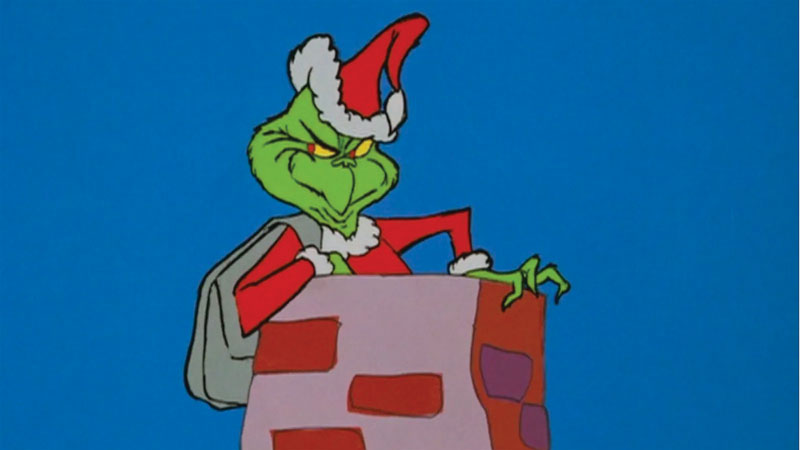
Targets (1968)
Karloff delivered one of his last great performances in thethriller Targets directed by Peter Bogdanovich. Targets is considered a significant film, not only for Boris Karloff’s memorable monologue, but also for its innovative blending of fictional and real-life elements. The film intertwines two separate storylines: One follows an aging horror film actor, Byron Orlok, portrayed by Karloff, who is set to retire from acting, while the other follows Bobby Thompson, a disturbed young man who embarks on a killing spree with a sniper rifle, indiscriminately targeting innocent people. The film explores the contrast between the classic era of horror cinema and real-life terror and serves as a cultural bridge between the two. Karloff delivers perhaps his most powerful monologue during the film’s climax.
Ladies and gentlemen, boys and girls, I’d like to leave you with a little story to think about as you drive home through the darkness. Once upon a time, many, many years ago, a rich merchant in Baghdad sent his servant to the marketplace to buy provisions. And after a while, the servant came back, white-faced and trembling, and said, “Master, when I was in the marketplace, I was jostled by a woman in the crowd, and I turned to look, and I saw that it was Death that jostled me. And she looked at me and made a threatening gesture. Oh, Master, please, lend me your horse, so that I may ride away from this city and escape my fate. I will ride to Samarra, and Death will not find me there.” So the merchant loaned him the horse, and the servant mounted it and dug his spurs into its flank, and as fast as the horse could gallop, he rode towards Samarra. Then the merchant went to the marketplace, and he saw Death standing in the crowd, and he said to her, “Why did you make a threatening gesture to my servant when you saw him this morning?” And Death said, “I made no threatening gesture. That was only a start of surprise. I was astonished to see him here in Baghdad, for I have an appointment with him tonight in Samarra.”
This scene contrasts the feelings evoked by the story with the situation ready to unfold and thereby serves to explain the distinction between horror and terror: Horror is the unease caused by having witnessed the thing, while terror is generally described as the sense of apprehension that precedes the thing itself. Most of what we call “horror” would best be described as “terror”. Preserving the line between the two was critical to Karloff’s success.

By delivering this monologue, Boris Karloff (no longer acting as Byron Orlok), serves as a meta-commentary on the state of horror cinema and its relevance in the face of real-life horrors and violence. The monologue not only reflects the changing landscape of the film industry in the late 1960s, but also raises thought-provoking questions about the role of horror films in society and the psychological impact of fear.
Influence on Modern Actors and Filmmakers
Boris Karloff’s ability to humanize and bring depth to his horror roles inspired a new generation. Jack Nicholson, known for his versatile and intense performances, has cited Karloff as an influence on his craft: He admired Karloff’s ability to elicit empathy and emotion from his characters, even when hidden behind layers of makeup and prosthetics, and also incorporated Karloff’s method of script annotation.
Similarly, modern filmmakers, especially those in the horror and fantasy genres, have drawn inspiration from Karloff’s work. Guillermo del Toro, the eccentric director known for his visually stunning and emotionally evocative films, has spoken about the profound impact Karloff has had on him as an artist; del Toro credits his appreciation for practical effects and the use of actors to convey emotion, rather than relying solely on CGI, to the work of horror legends like Karloff.
Karloff’s influence transcends mere cinematic terror. He wasn’t merely the harbinger of fright; he was a catalyst for change. In an industry rife with exploitation, he wielded his prominence to rally for the rights of his fellow thespians, birthing the Screen Actors Guild into existence. A guardian of the artist’s soul, he sought to shield each one from the shadows that lurked behind the dazzling lights of Hollywood.
Boris Karloff remains an eternal sentinel, a guardian of the macabre, and a herald of empathy. In the grand tapestry of Hollywood’s legends, his threads are woven intricately, bringing texture and depth to the world of entertainment. His influence ripples through time, an indomitable force that forever whispers, reminding us that, even in the darkest corners, a spark of humanity can shine through, leaving a memorable impression on our collective soul.
Fin.
Have you never wanted to do anything that was dangerous? Where should we be if no one tried to find out what lies beyond? Have you never wanted to look beyond the clouds and the stars, or to know what causes the trees to bud? And what changes the darkness into light? But if you talk like that, people call you crazy. Well, if I could discover just one of these things, what eternity is, for example, I wouldn’t care if they did think I was crazy.
- Dr. Frankenstein
Written By: Mike Dynes
Edited by: VanHeat & Trent Collicot
Boris Karloff's Gold Key Mysteries
-
Boris Karloff's Gold Key Mysteries #1
Regular price $5.99 USDRegular priceUnit price / per -
Boris Karloff's Gold Key Mysteries - Gold Key Exclusive
Regular price $25.00 USDRegular priceUnit price / per -
Boris Karloff's Gold Key Mysteries - NYCC Gold Foil Exclusive
Regular price $50.00 USDRegular priceUnit price / per -
Boris Karloff's Gold Key Mysteries #2
Regular price $5.99 USDRegular priceUnit price / per -
Boris Karloff's Gold Key Mysteries #2 Shortboxed-Skinner Variant
Regular price $40.00 USDRegular priceUnit price / per -
Boris Karloff's Gold Key Mysteries Issue 1 PDF
Regular price $5.00 USDRegular priceUnit price / per -
Boris Karloff's Gold Key Mysteries Issue 2 PDF
Regular price $5.00 USDRegular priceUnit price / per -
Boris Karloff's Gold Key Mysteries #2 Mad Charcoal Variant
Regular price $12.00 USDRegular priceUnit price / per


